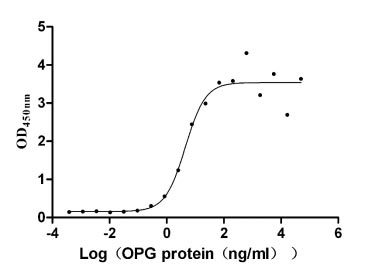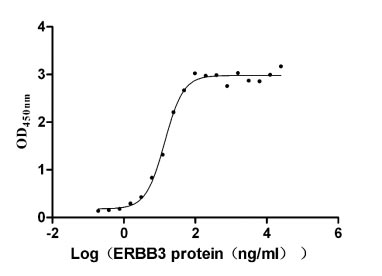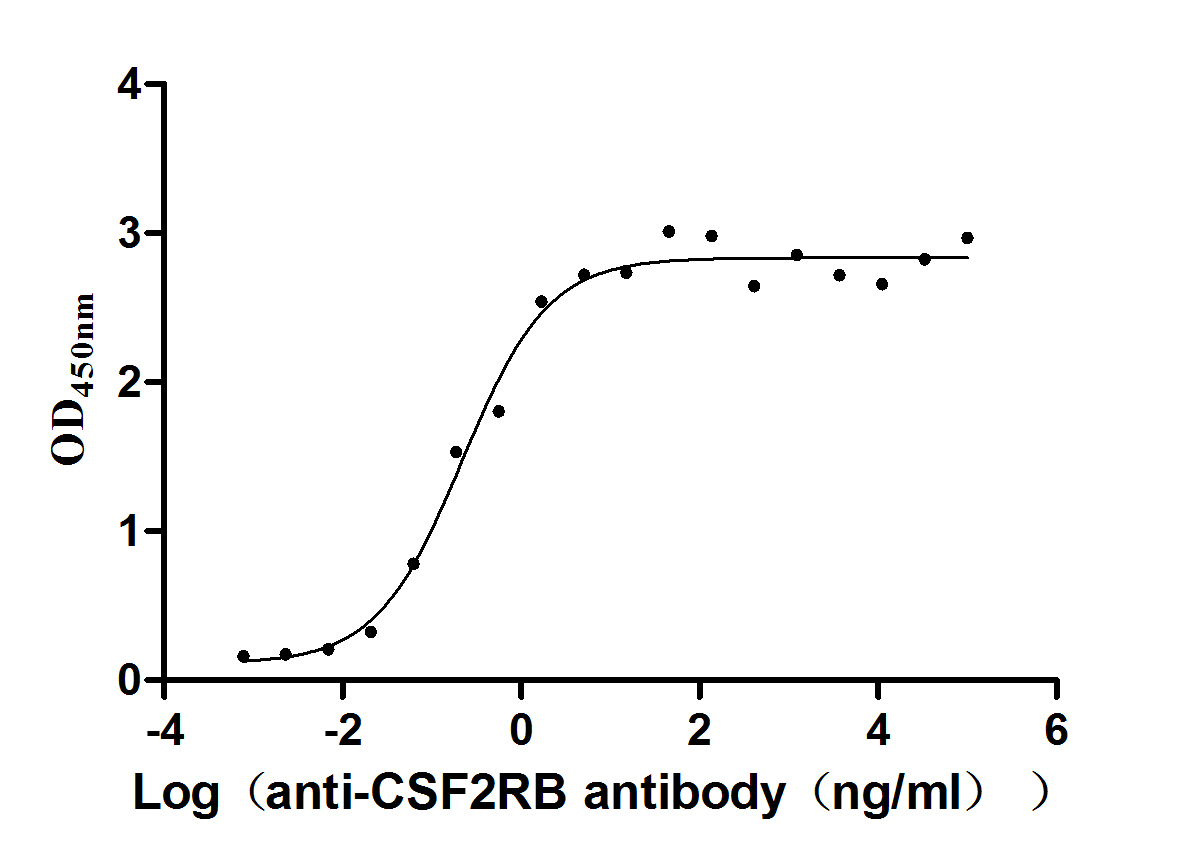Recombinant Rat Protein kinase C delta type (Prkcd)
-
货号:CSB-YP018702RA
-
规格:
-
来源:Yeast
-
其他:
-
货号:CSB-EP018702RA
-
规格:
-
来源:E.coli
-
其他:
-
货号:CSB-EP018702RA-B
-
规格:
-
来源:E.coli
-
共轭:Avi-tag Biotinylated
E. coli biotin ligase (BirA) is highly specific in covalently attaching biotin to the 15 amino acid AviTag peptide. This recombinant protein was biotinylated in vivo by AviTag-BirA technology, which method is BriA catalyzes amide linkage between the biotin and the specific lysine of the AviTag.
-
其他:
-
货号:CSB-BP018702RA
-
规格:
-
来源:Baculovirus
-
其他:
-
货号:CSB-MP018702RA
-
规格:
-
来源:Mammalian cell
-
其他:
产品详情
-
纯度:>85% (SDS-PAGE)
-
基因名:
-
Uniprot No.:
-
别名:Prkcd; PkcdProtein kinase C delta type; EC 2.7.11.13; nPKC-delta) [Cleaved into: Protein kinase C delta type regulatory subunit; Protein kinase C delta type catalytic subunit; Sphingosine-dependent protein kinase-1; SDK1)]
-
种属:Rattus norvegicus (Rat)
-
蛋白长度:Full length protein
-
表达区域:1-673
-
氨基酸序列MAPFLRISFN SYELGSLQAE DDASQPFCAV KMKEALTTDR GKTLVQKKPT MYPEWKSTFD AHIYEGRVIQ IVLMRAAEDP MSEVTVGVSV LAERCKKNNG KAEFWLDLQP QAKVLMCVQY FLEDGDCKQS MRSEEEAMFP TMNRRGAIKQ AKIHYIKNHE FIATFFGQPT FCSVCKEFVW GLNKQGYKCR QCNAAIHKKC IDKIIGRCTG TATNSRDTIF QKERFNIDMP HRFKVYNYMS PTFCDHCGTL LWGLVKQGLK CEDCGMNVHH KCREKVANLC GINQKLLAEA LNQVTQKASR KPETPETVGI YQGFEKKTAV SGNDIPDNNG TYGKIWEGSN RCRLENFTFQ KVLGKGSFGK VLLAELKGKE RYFAIKYLKK DVVLIDDDVE CTMVEKRVLA LAWENPFLTH LICTFQTKDH LFFVMEFLNG GDLMFHIQDK GRFELYRATF YAAEIICGLQ FLHGKGIIYR DLKLDNVMLD KDGHIKIADF GMCKENIFGE NRASTFCGTP DYIAPEILQG LKYSFSVDWW SFGVLLYEML IGQSPFHGDD EDELFESIRV DTPHYPRWIT KESKDIMEKL FERDPAKRLG VTGNIRLHPF FKTINWNLLE KRKVEPPFKP KVKSPSDYSN FDPEFLNEKP QLSFSDKNLI DSMDQTAFKG FSFVNPKYEQ FLE
-
蛋白标签:Tag type will be determined during the manufacturing process.
The tag type will be determined during production process. If you have specified tag type, please tell us and we will develop the specified tag preferentially. -
产品提供形式:Lyophilized powder
Note: We will preferentially ship the format that we have in stock, however, if you have any special requirement for the format, please remark your requirement when placing the order, we will prepare according to your demand. -
复溶:We recommend that this vial be briefly centrifuged prior to opening to bring the contents to the bottom. Please reconstitute protein in deionized sterile water to a concentration of 0.1-1.0 mg/mL.We recommend to add 5-50% of glycerol (final concentration) and aliquot for long-term storage at -20℃/-80℃. Our default final concentration of glycerol is 50%. Customers could use it as reference.
-
储存条件:Store at -20°C/-80°C upon receipt, aliquoting is necessary for mutiple use. Avoid repeated freeze-thaw cycles.
-
保质期:The shelf life is related to many factors, storage state, buffer ingredients, storage temperature and the stability of the protein itself.
Generally, the shelf life of liquid form is 6 months at -20°C/-80°C. The shelf life of lyophilized form is 12 months at -20°C/-80°C. -
货期:Delivery time may differ from different purchasing way or location, please kindly consult your local distributors for specific delivery time.Note: All of our proteins are default shipped with normal blue ice packs, if you request to ship with dry ice, please communicate with us in advance and extra fees will be charged.
-
注意事项:Repeated freezing and thawing is not recommended. Store working aliquots at 4°C for up to one week.
-
Datasheet :Please contact us to get it.
靶点详情
-
功能:Calcium-independent, phospholipid- and diacylglycerol (DAG)-dependent serine/threonine-protein kinase that plays contrasting roles in cell death and cell survival by functioning as a pro-apoptotic protein during DNA damage-induced apoptosis, but acting as an anti-apoptotic protein during cytokine receptor-initiated cell death, is involved in tumor suppression, is required for oxygen radical production by NADPH oxidase and acts as positive or negative regulator in platelet functional responses. Upon DNA damage, activates the promoter of the death-promoting transcription factor BCLAF1/Btf to trigger BCLAF1-mediated p53/TP53 gene transcription and apoptosis. In response to oxidative stress, interact with and activate CHUK/IKKA in the nucleus, causing the phosphorylation of p53/TP53. In the case of ER stress or DNA damage-induced apoptosis, can form a complex with the tyrosine-protein kinase ABL1 which trigger apoptosis independently of p53/TP53. In cytosol can trigger apoptosis by activating MAPK11 or MAPK14, inhibiting AKT1 and decreasing the level of X-linked inhibitor of apoptosis protein (XIAP), whereas in nucleus induces apoptosis via the activation of MAPK8 or MAPK9. Upon ionizing radiation treatment, is required for the activation of the apoptosis regulators BAX and BAK, which trigger the mitochondrial cell death pathway. Can phosphorylate MCL1 and target it for degradation which is sufficient to trigger for BAX activation and apoptosis. Is required for the control of cell cycle progression both at G1/S and G2/M phases. Mediates phorbol 12-myristate 13-acetate (PMA)-induced inhibition of cell cycle progression at G1/S phase by up-regulating the CDK inhibitor CDKN1A/p21 and inhibiting the cyclin CCNA2 promoter activity. In response to UV irradiation can phosphorylate CDK1, which is important for the G2/M DNA damage checkpoint activation. Can protect glioma cells from the apoptosis induced by TNFSF10/TRAIL, probably by inducing increased phosphorylation and subsequent activation of AKT1. Can also act as tumor suppressor upon mitogenic stimulation with PMA or TPA. In N-formyl-methionyl-leucyl-phenylalanine (fMLP)-treated cells, is required for NCF1 (p47-phox) phosphorylation and activation of NADPH oxidase activity, and regulates TNF-elicited superoxide anion production in neutrophils, by direct phosphorylation and activation of NCF1 or indirectly through MAPK1/3 (ERK1/2) signaling pathways. Involved in antifungal immunity by mediating phosphorylation and activation of CARD9 downstream of C-type lectin receptors activation, promoting interaction between CARD9 and BCL10, followed by activation of NF-kappa-B and MAP kinase p38 pathways. May also play a role in the regulation of NADPH oxidase activity in eosinophil after stimulation with IL5, leukotriene B4 or PMA. In collagen-induced platelet aggregation, acts a negative regulator of filopodia formation and actin polymerization by interacting with and negatively regulating VASP phosphorylation. Downstream of PAR1, PAR4 and CD36/GP4 receptors, regulates differentially platelet dense granule secretion; acts as a positive regulator in PAR-mediated granule secretion, whereas it negatively regulates CD36/GP4-mediated granule release. Phosphorylates MUC1 in the C-terminal and regulates the interaction between MUC1 and beta-catenin. The catalytic subunit phosphorylates 14-3-3 proteins (YWHAB, YWHAZ and YWHAH) in a sphingosine-dependent fashion. Phosphorylates ELAVL1 in response to angiotensin-2 treatment. Phosphorylates mitochondrial phospolipid scramblase 3 (PLSCR3), resulting in increased cardiolipin expression on the mitochondrial outer membrane which facilitates apoptosis. Phosphorylates SMPD1 which induces SMPD1 secretion.; Truncated isoform 2 is inactive.
-
基因功能参考文献:
- Results show that PKCdelta is activated in platelets during sepsis and that PKCdelta inhibition decreases sepsis-induced platelet activation and their interaction with leukocytes both systemically and in the lung in the cecal ligation and puncture model of sepsis in rats. PMID: 29617417
- microRNA-133a can protect cardiomyocyte hypertrophy against norepinephrine stimulation in neonatal rat ventricular cardiomyocytes via new targets, PKCdelta and Gq, all of which are related to downstream signaling pathways of the alpha1-adrenergic receptor. PMID: 28795305
- In a well-known rodent model of sepsis, the inhibition of PKCdelta attenuates neutrophil migration into the lung tissue in vivo. PMID: 27190303
- The findings suggested that periodic mechanical stress promoted chondrocyte proliferation through PKCdelta-EGFR-PI3K-Akt-ERK1/2. PMID: 27606614
- the deltaPKC-dF1Fo inhibitor attenuated co-immunoprecipitation of deltaPKC with dF1Fo. PMID: 26519110
- Phosphorylation site at Ser130 adjacent to the pseudosubstrate domain contributes to the activation of protein kinase. PMID: 26546672
- PRKCBII and PRKCD-dependent inactivation of p38 regulates cardiac fibroblast proliferation and collagen deposition in response to angiotensin II. PMID: 25659900
- Studied role of melatonin in modulating P-type Ca(2+) channels and action-potential firing in rat Purkinje neurons and found melatonin application increased the membrane abundance of PKCdelta, and PKCdelta inhibition abolished the melatonin-induced IBa response. PMID: 25707622
- Studies identify a C2 domain pTyr313 docking interaction that controls ATP-positioning loop phosphorylation as a novel, dynamically regulated, and physiologically relevant structural determinant of PKCdelta catalytic activity. PMID: 25755284
- Prenatal testosterone exposure induces hypertension in adult females via androgen receptor-dependent protein kinase Cdelta-mediated mechanism. PMID: 25489059
- our results demonstrate that PKCd phosphorylation at Ser/Tyr plays a critical role in the modulation of gastric mucosal inflammatory responses to H. pylori LPS by ghrelin PMID: 24840386
- Three subtypes, PKC-delta, PKC-gamma and PKC-alpha are likely to be involved the phosphorylation suppression of ERK included cyclic guanosine monophosphate. PMID: 24914766
- The Prkcd pathway induces MMP-9 expression which is required for brain astrocyte migration. PMID: 24018979
- These results identified PKCdelta as an essential PKC isoform involved in the activation of SOCE, and confirmed that PKC regulates the function of ASMCs in a SOCE-dependent manner. PMID: 22684549
- Data suggest that PKC delta, rather than classic-type PKC (alpha, beta1, beta2, gamma), participates in 6-OHDA-induced neurotoxicity in PC12 cells, and PKC delta activity is required for subsequent ERK activation during cell death PMID: 24107416
- PKCdelta has an important role in regulating neutrophil-endothelial cell interactions and recruitment to the inflamed lung. PMID: 24211111
- PKCdelta activates NF-kappaB through an IkappaB-independent cytosolic interaction PMID: 24519937
- Our findings suggest that ischemia preconditioning protects against ischemia reperfusion-induced hepatic injury through activation of PKC-delta. PMID: 23932656
- siRNA to PKC delta attenuates the proinflammatory effect of human CRP in spontaneously diabetic BB rats and could have implications with regard to attenuating inflammation and vascular complications in T1DM. PMID: 23104422
- In the lateral amygdala, 20-25% of low-threshold bursting and regular-spiking neurons are protein kinase Cdelta positive. PMID: 22972957
- PKCdelta can be a central mediator of reactive oxygen species (ROS) generation and dopaminergic cell death via paraquat exposure. PMID: 23827392
- Results suggest that arsenite (As(III)) retards the cardiac differentiation of H9c2 cells, at least partly, via the inhibition of PKCdelta phosphorylation. PMID: 23727579
- The PKCdelta and p38MAPK pathway is a strong contributor to apoptosis in the non-infarcted myocardium. PMID: 23010893
- Go6976 promotes PC12 cell adhesion and spreading through membrane recruitment and activation of protein kinase Cdelta. PMID: 23063429
- an appropriate activation and translocation of PKCdelta may represent a mechanism whereby EP can exert an early cardioprotection against exhaustive exercise-induced myocardial injury. PMID: 22648735
- PKCdelta mediates ERK and JNK activation in the LPA signaling pathway and that this pathway is required for LPA-induced gene regulation as evidenced by Egr-1 expression. PMID: 22577133
- Our data suggest that the diabetes-related enhancement of EP3 receptor-mediated vasocontraction results from activation of the PKCdelta pathway. PMID: 22371141
- PKC delta plays important roles in intracranial hemorrhage(ICH) and thrombin-induced brain injury. Dihydrochloride (H7) can attenuate brain damage after ICH. PMID: 21172324
- The involvement of CaSR in cardiac apoptosis through the mitochondrial pathway during ischemia/reperfusion is related to phospho-PKCdelta translocation to the mitochondria. PMID: 21766206
- Activation of duodenal PKC-delta leads to the stimulation of CCK release and activation of the CCK-A receptor signaling axis to lower glucose production in normal rats. PMID: 21984583
- Duodenal mucosal protein kinase C-delta regulates glucose production in rats. PMID: 21704002
- Study of the (1)H, (15)N and (13)C NMR chemical shift assignments for the Rattus norvegicus PKCdelta C1A and C1B proteins. PMID: 21132404
- Regulated binding of importin-alpha to protein kinase Cdelta in response to apoptotic signals facilitates nuclear import. PMID: 21865164
- TRPM4 channels are mobile in native cerebral myocytes and that basal PKCdelta activity supports excitability of these cells by maintaining localization TRPM4 protein at the plasma membrane. PMID: 21406958
- PKCdelta activation dysregulates the mitochondrial fission machinery and induces aberrant mitochondrial fission, thus contributing to neurological pathology PMID: 21119009
- Using yeast cells co-expressing the human wild-type p53 and a single mammalian PKCalpha, delta, epsilon or zeta, results showed a differential regulation of p53-mediated apoptosis by these PKC isoforms. PMID: 21338602
- phosphorylated PKCdelta activates SC35 splicing factor during H9c2 cardiomyoblastic differentiation PMID: 21117027
- effects of chronic intermittent hypoxia (CIH; 7,000 m, 8 h/day) and acute administration of PKC-delta inhibitor (rottlerin, 0.3 mg/kg) on the expression and subcellular distribution of PKC-delta and PKC-epsilon in the left ventricular myocardium of rats PMID: 20853175
- PKC-delta signalling pathway is involved in H9c2 cells differentiation PMID: 20817341
- Data show that native PKCdelta forms complexes with endogenous Shc proteins in hydrogen peroxide-treated cardiomyocytes; treatment also leads to the accumulation of PKCdelta and Shc in a detergent-insoluble cytoskeletal fraction and in mitochondria. PMID: 20686066
- PKCdelta activity causes smooth muscle depolarization and vasoconstriction by increasing the number of TRPM4 channels in the sarcolemma. PMID: 20610768
- Activation of PKC-delta promotes tubular cell injury and death during albuminuria. PMID: 20395372
- disruption of the PKCdelta-dF1Fo interaction using cell-permeant mitochondrial-targeted peptides attenuates cardiac injury resulting from prolonged oxygen deprivation PMID: 20578995
- Oxidative stress produced in hyperhomocysteinemic rat hearts during reperfusion may activate PKC-delta It may be implicated in the paradoxically abrogated cardioprotective potentials of ischemic preconditioning in hyperhomocysteinemic hearts. PMID: 19914792
- PKCbetaII and PKCdelta counter-regulate BBB permeability during aglycemic hypoxia. PMID: 19900507
- Protein kinase C delta mediates arterial injury responses through regulation of vascular smooth muscle cell apoptosis. PMID: 19808702
- decreases the accumulation of the pro-apoptotic kinase, deltaPKC, at cardiac mitochondria, resulting in the accumulation of the pro-survival kinase, epsilonPKC. PMID: 19820255
- PKC delta plays an important role in the propagation of the TNFalpha signal regulating stress kinase activation and ER stress-mediated JNK activation and CHOP induction. PMID: 19782747
- Data show that the PKC delta inhibitor did not affect stimulated amylase secretion from pancreatic acinar cells. PMID: 19752773
- high oxidative stress produced in hyperhomocysteinemic rat hearts during reperfusion may activate PKC-delta PMID: 19914793
显示更多
收起更多
-
亚细胞定位:Cytoplasm. Nucleus. Cytoplasm, perinuclear region. Cell membrane; Peripheral membrane protein. Mitochondrion. Endomembrane system.
-
蛋白家族:Protein kinase superfamily, AGC Ser/Thr protein kinase family, PKC subfamily
-
数据库链接:
KEGG: rno:170538
STRING: 10116.ENSRNOP00000025858
UniGene: Rn.98279
Most popular with customers
-
Recombinant Human B-cell receptor CD22 (CD22), partial (Active)
Express system: Mammalian cell
Species: Homo sapiens (Human)
-
Recombinant Human Tumor necrosis factor receptor superfamily member 11B (TNFRSF11B) (Active)
Express system: Mammalian cell
Species: Homo sapiens (Human)
-
Recombinant Human Receptor tyrosine-protein kinase erbB-3 (ERBB3), partial (Active)
Express system: Mammalian cell
Species: Homo sapiens (Human)
-
Recombinant Human Leukemia inhibitory factor (LIF) (Active)
Express system: Mammalian cell
Species: Homo sapiens (Human)
-
Recombinant Human Cytokine receptor common subunit beta (CSF2RB), partial (Active)
Express system: Mammalian cell
Species: Homo sapiens (Human)
-
Recombinant Mouse Prolactin receptor (Prlr), partial (Active)
Express system: Mammalian cell
Species: Mus musculus (Mouse)
-
Recombinant Rat Microtubule-associated protein tau (Mapt) (Active)
Express system: Mammalian cell
Species: Rattus norvegicus (Rat)
-
Recombinant Human Claudin-4 (CLDN4)-VLPs (Active)
Express system: Mammalian cell
Species: Homo sapiens (Human)




















